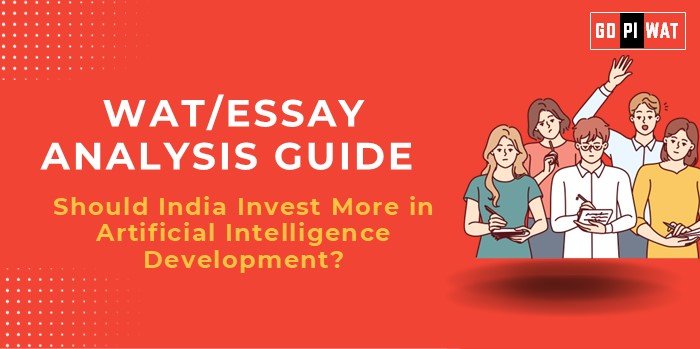📋 Group Discussion Analysis Guide: Should India Invest More in Artificial Intelligence Development?
🌐 Introduction to the Topic
Artificial Intelligence (AI) is reshaping industries globally, influencing areas like healthcare, education, defense, and governance. With its rapidly expanding digital economy, India faces the critical need to accelerate AI investments to maintain global competitiveness and drive innovation.
AI is a catalyst for economic transformation, supported by initiatives like India’s National AI Strategy and the establishment of research hubs. However, significant investment in infrastructure, skills, and policy is essential to unlock its full potential.
📊 Quick Facts and Key Statistics
- 📈 AI Market Growth: Valued at $5.2 billion in 2022, projected to grow to $23.4 billion by 2032.
- 🏢 Startup Ecosystem: India hosts 300+ AI startups, positioning it among the top global AI hubs.
- 💰 Economic Impact: AI is projected to add $967 billion to India’s GDP by 2035 (NASSCOM).
- 🌟 Public Investment: ₹10,371.92 crore allocated for AI development under the Digital India initiative (2024).
👥 Stakeholders and Their Roles
- 🏛️ Government Agencies: Provide policy support, research grants, and infrastructure for AI growth.
- 💻 Private Sector: Drive innovation and deploy AI solutions in industries like finance, healthcare, and logistics.
- 🎓 Academia: Develop AI talent and conduct foundational research.
- 👨👩👧 Citizens: Benefit from AI-driven improvements in healthcare, public services, and education.
🏆 Achievements and Challenges
Achievements
- 🌍 Economic Potential: NASSCOM projects AI could contribute $967 billion to India’s GDP by 2035.
- 🌐 Startup Ecosystem: With over 300 AI startups, India is emerging as a global AI innovation hub.
- 📊 Government Support: Allocation of ₹10,371.92 crore for AI research demonstrates policy focus.
Challenges
- 💻 Infrastructure Deficit: Inadequate cloud computing facilities and research labs compared to global leaders like China.
- 👩🏫 Skill Gaps: Limited AI-trained workforce hampers scalability.
- 🛡️ Data Privacy Issues: The absence of comprehensive data protection laws restricts growth.
🌍 Global Comparisons
- 🇨🇳 China: Leads with $70 billion in annual AI investments, focusing on patents and AI parks.
- 🇺🇸 USA: Maintains leadership through a focus on ethical AI and extensive R&D.
💡 Structured Arguments for Discussion
- ✅ Supporting Stance: “Increased investment in AI will enable India to harness its economic and demographic potential effectively.”
- ❌ Opposing Stance: “India risks wasting resources on AI unless foundational issues like education and infrastructure are addressed first.”
- ⚖️ Balanced Perspective: “While AI investments are critical, equitable infrastructure and robust policy frameworks are necessary for sustainable growth.”
🛠️ Effective Discussion Approaches
- 📊 Opening Approaches:
- “India’s AI market is projected to grow to $23.4 billion by 2032, reflecting immense growth potential.”
- “With $967 billion in projected GDP contributions by 2035, AI is a transformative opportunity for India.”
- 🛡️ Counter-Argument Handling:
- “While infrastructure gaps exist, public-private partnerships can accelerate development.”
- “Ethical concerns can be addressed through robust data protection frameworks modeled on GDPR.”
🔍 Strategic Analysis of Strengths and Weaknesses
- 💪 Strengths: Rapidly growing startup ecosystem, government initiatives, young workforce.
- ❌ Weaknesses: Lack of AI-ready infrastructure, skill shortages, inconsistent data policies.
- 🌟 Opportunities: Integration in smart cities, global AI collaborations, and health-tech innovations.
- ⚠️ Threats: Intense global competition, cybersecurity vulnerabilities.
📖 Connecting with B-School Applications
- 💼 Real-World Applications: Case studies on AI-driven marketing and supply chain analytics.
- 🎓 Sample Interview Questions:
- “How should India balance AI investments with foundational infrastructure needs?”
- “What ethical frameworks are essential for AI development?”
- 🔎 Insights for Students: Explore AI’s role in decision-making, public-private models, and sustainable development strategies.


